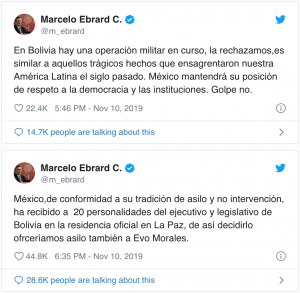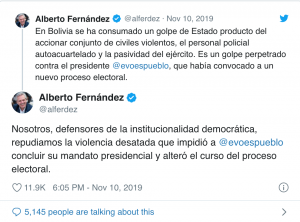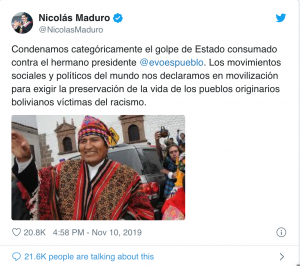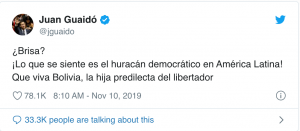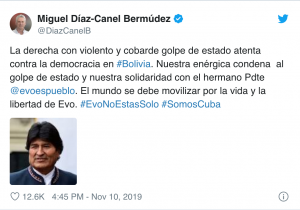
Evo Morales announces his resignation on November 10th.
On November 10th, 2019, Bolivia’s three-term president stepped down after weeks of widespread protests and violence due to the results of the October 20th election, in which Morales achieved a surprise victory over his opponent Carlos de Mesa. In Bolivian elections, a candidate requires either 50 percent of the vote, or at least 40 percent with a 10 percentage point lead over the next candidate (CEPR). If a candidate doesn’t reach either of these, the top two candidates are placed into a runoff election against one another. In Bolivia, there are also two vote-counting systems. The first is the “quick count”, a system which gives a count of the votes received on election night for use by the media. The second is the official count, which usually takes longer to count, includes all votes, and is the only system that is legally binding (CEPR). The quick count gave Morales a lead over de Mesa, but not the 10 percentage point lead he needed to avoid a runoff election. A few days later, the final election results through the official count were delivered, and Morales won with just over a 10 percentage point lead.
Subsequently, the opposition to Morales denounced him and his results and took to the streets in protest. The opposition cites his decision to run for a fourth term despite his promise that he wouldn’t, his successful removal of term limits through the constitutional court declaring them a human rights violation, his decision to build a luxury presidential palace and a museum dedicated to himself, and the fact that the votes he needed to win coming in at the last minute as justification for their belief that the election was illegitimate (CNN). After weeks of protest and calls to resign, Morales offered to hold a second election. However, the opposition and Bolivian protestors were not placated by this, and with the military joining in against Morales, him and much of his cabinet stepped down in an attempt to “stop the bloodshed” (NYT), and stating that what was occurring was a coup.

Carlos de Mesa speaking to the media.
Morales’s supporters agree that a coup occurred. They cite widespread right-wing violence in the weeks after the election for calling this a coup, with terror tactics such as Carlos de Mesa’s party paying youths to cause chaos as primary examples (teleSUR). Racism is also said to be a motivation behind this alleged coup. Morales is the first indigenous president of Bolivia and is immensely popular with the indigenous people of the country due to his major reforms. Much violence has been specifically targeted towards indigenous women, such as when a mayor of Morales’s party “was beaten, dragged through the dirt and doused with red paint in ritual fashion” (teleSUR). Furthermore, many of the votes which gave Morales his belated lead were from rural areas with a high indigenous population, areas which historically report late and heavily favor Morales.
What I found highly interesting was how the event has been portrayed in United States media outlets versus Telesur, a Latin American news network sponsored by Venezuela, Cuba, Nicaragua, Uruguay, and Bolivia. The New York Times portrays Morales as a leader desperately trying to hold on to power, but does make note of his accomplishments of lifting many out of poverty. Both the New York Times and CNN describe the response to Morales as an “rebellion” (NYT) of the people against an oppressive ruler, both portray the delayed votes as the votes being delayed without any known reason, and cite the OAS as evidence that the election results were highly irregular. Telesur takes a diametrically opposed viewpoint. It, unlike the other articles, mentions that Morales’s party asked the OAS to recount the results, and characterizes the opposition as seeking to seize power in any way possible, not caring about the results of the election. Telesur does not mention Morales successfully petitioning to have term limits removed, or any criticisms of his actions as president. It should be noted that the Center for Economic and Policy Research (CEPR), a think-tank based in Washington D.C., has examined the results of the election and found nothing out of line in this election when compared to previous elections, calling the OAS’s decision to question the election results without providing any evidence as “very unusual, and highly questionably” (CEPR).

Jeanine Áñez, the current president of Bolivia. She was 5th in the line of succession as Second Vice President of the Senate.
In the context of our class themes, I see these events as indicative of a counterrevolution, most similar to what occurred in Chile in 1973. Morales as president was a popular leftist leader, who was forced out of office by the actions of the military, an event very obviously reminiscent of Allende’s fall (do note that the New York Times clarifies that this is not an “old-school coup in which the military aims to take power itself”). Furthermore, this comes after Bolivia’s cancelling of an agreement with a foreign firm to mine lithium in the country (Common Dreams), much like how the Chilean nationalization of copper in 1971 under Allende prompted the military coup there and then. The OAS is also a major player in these recent events, hearkening back to our class examination of Fidel Castro’s denouncement of the OAS, and adding in themes of imperialism and neocolonialism. Finally, US support of dictatorship can be seen in the portrayal of these events, as the New York Times article ends with a quote from far-right President of Brazil Jair Bolsonaro, an authoritarian leader who has on numerous occasions praised Brazil’s oppressive military dictatorship—quite literally giving him the last word in this matter.
Works Cited:
Beeton, Dan. “No Evidence That Bolivian Election Results Were Affected by Irregularities or Fraud, Statistical Analysis Shows: Press Releases.” CEPR, Center for Economic and Policy Research, 8 Nov. 2019, http://cepr.net/press-center/press-releases/no-evidence-that-bolivian-election-results-were-affected-by-irregularities-or-fraud-statistical-analysis-shows.
Forster, Cindy. “Bolivia in Crosshairs of US Counter-Revolution.” TeleSUR English, TeleSUR, 11 Nov. 2019, https://www.telesurenglish.net/opinion/Bolivia-in-Crosshairs-of-US-Counter-revolution-20191111-0004.html.
Ghitis, Frida. “Bolivia’s Blunt Message to Leaders Drunk on Power.” CNN, Cable News Network, 11 Nov. 2019, https://www.cnn.com/2019/11/11/opinions/bolivia-evo-morales-ghitis/index.html.
Higgins, Eoin. “Bolivian Coup Comes Less Than a Week After Morales Stopped Multinational Firm’s Lithium Deal.” Common Dreams, Common Dreams, 11 Nov. 2019, https://www.commondreams.org/news/2019/11/11/bolivian-coup-comes-less-week-after-morales-stopped-multinational-firms-lithium-deal.
Londoño, Ernesto. “Bolivian Leader Evo Morales Steps Down.” The New York Times, The New York Times, 10 Nov. 2019, https://www.nytimes.com/2019/11/10/world/americas/evo-morales-bolivia.html.
